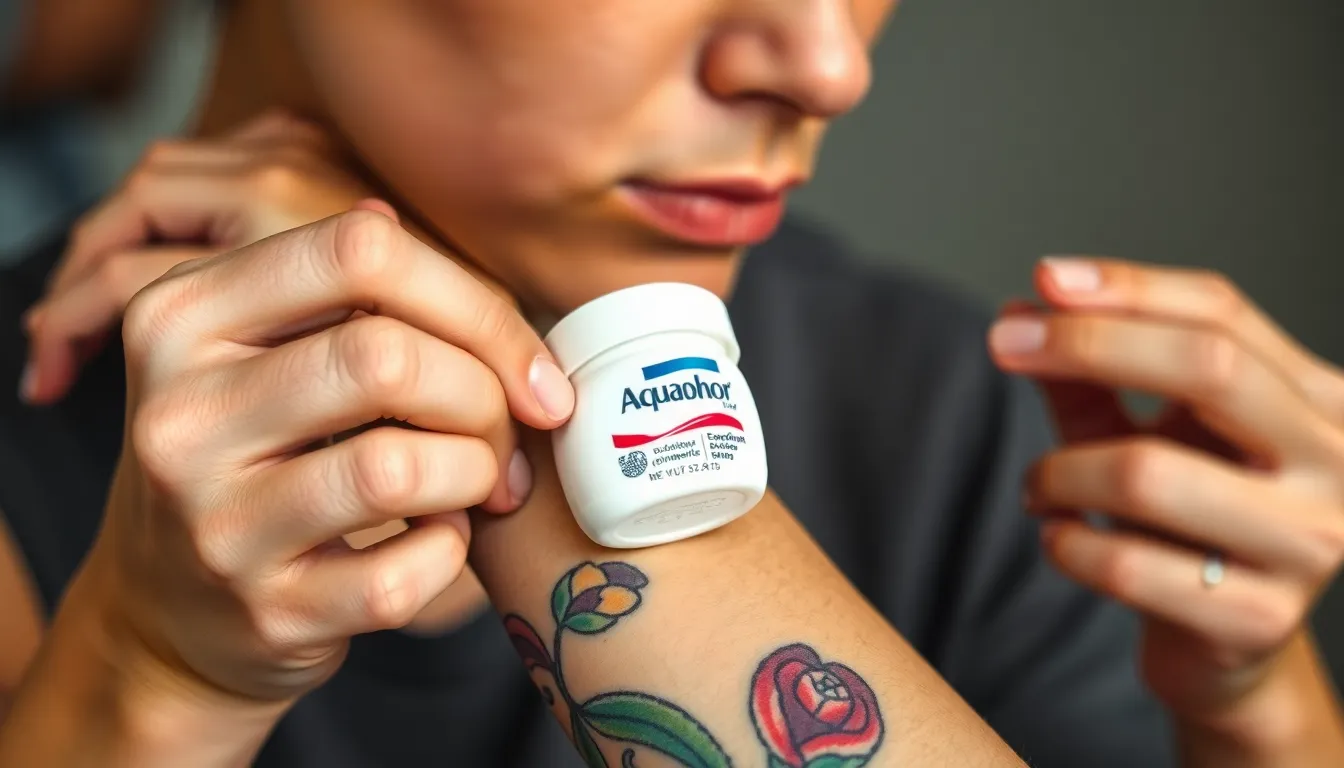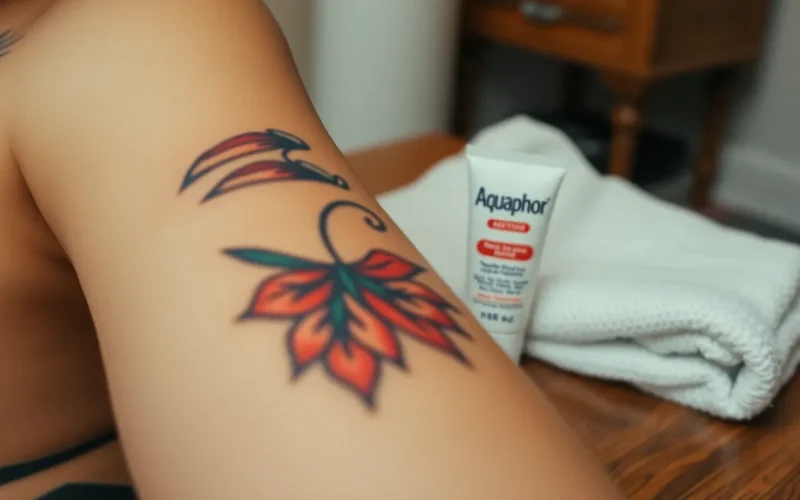Table of Contents
ToggleGetting a tattoo is like committing to a lifelong relationship with art. You want it to look stunning, vibrant, and as flawless as the day you got it. But what happens when that fresh ink starts to feel like a rebellious teenager? Enter Aquaphor, the magical potion that promises to soothe and hydrate. But can you really slather it on your new tattoo without turning it into a slippery mess?
In the world of tattoo aftercare, opinions are as varied as the ink colors available. Some swear by Aquaphor, claiming it’s the secret sauce to healing, while others raise an eyebrow at the thought. So, before you dive into the tub of this healing balm, let’s explore whether it’s a tattoo’s best friend or just a slippery slope.
Can You Put Aquaphor On A Tattoo?
Applying Aquaphor on a tattoo aids in the healing process. This product contains petrolatum, which creates a protective barrier. Healing tattoos often experience dryness, and Aquaphor helps combat this by locking in moisture.
Many tattoo artists recommend Aquaphor during the initial phases of healing. They suggest using a thin layer to avoid over-saturation. Overuse may prevent the tattoo from breathing properly, potentially leading to complications.
Timing matters when applying Aquaphor. It’s best to start using it 24 to 48 hours after getting tattooed. Immediate application may interfere with the tattoo’s integrity.
Aquaphor can assist in reducing scabs and itching, promoting quicker recovery. Observing the tattoo during the healing stage remains crucial. If signs of irritation or infection appear, discontinuing Aquaphor is essential.
Alternatives exist for tattoo aftercare as well. Some individuals prefer fragrance-free moisturizers or specialized tattoo ointments. Comparing these options can inform better choices for tattoo care.
Overall, Aquaphor serves as an effective option for many, but it’s not universally recommended. Conducting thorough research or consulting with a tattoo professional will provide tailored advice for individual situations. A personalized approach enhances the overall healing experience.
Benefits Of Using Aquaphor On Tattoos

Aquaphor offers several advantages for tattoo aftercare, making it a popular choice among both artists and clients.
Moisture Retention
Moisture retention plays a crucial role in tattoo healing, and Aquaphor excels at this function. The ointment’s occlusive properties create a protective barrier that locks in moisture. As the tattoo heals, this barrier prevents the skin from drying out, reducing the risk of flaking and cracking. Optimal moisture levels help maintain the tattoo’s vibrancy, ensuring that colors remain bold. Many tattoo artists recommend applying Aquaphor a few days post-application, enhancing the healing environment. A well-hydrated tattoo often heals faster, making Aquaphor an appealing option for effective aftercare.
Soothing Irritation
Soothing irritation becomes essential during the tattoo healing process. Aquaphor serves as a multipurpose ointment, providing relief from itching and discomfort. Its formulation includes soothing ingredients that calm inflamed skin, offering a slight cooling effect. Applying a thin layer can mitigate the urge to scratch, which is critical for protecting the integrity of the tattoo. Many individuals find that regular use reduces the appearance of redness and irritation, contributing to a more pleasant healing experience. By addressing discomfort effectively, Aquaphor promotes overall satisfaction with the tattoo process.
Potential Risks And Considerations
Understanding the potential risks associated with applying Aquaphor on tattoos is essential for proper aftercare. Users should remain cautious about specific concerns that may arise.
Allergic Reactions
Some individuals might experience allergic reactions to Aquaphor’s ingredients. Symptoms can include redness, swelling, or an unusual rash. Recognizing these signs is critical for maintaining tattoo health. Testing the product on a small skin area prior to application can help identify possible sensitivities. Not everyone experiences these reactions, but observing the skin’s response upon first use is wise.
Infections
Applying Aquaphor improperly can increase the risk of infections. Using excessive amounts or failing to keep the tattoo clean may trap bacteria. Signs of infection include increased pain, pus, or an unnatural odor. Users should clean the tattoo gently with mild soap before application. Consulting a tattoo artist or healthcare professional if infection symptoms develop ensures prompt and appropriate treatment. Keeping the area dry is crucial for preventing infection while also promoting healing.
Best Practices For Applying Aquaphor
Applying Aquaphor correctly supports optimal tattoo healing. Following recommended guidelines ensures that the tattoo remains vibrant and irritation-free.
When To Apply
Tattoo artists often recommend starting application 24 to 48 hours after getting a tattoo. He or she should wait until the initial healing phase begins to allow the tattoo to settle. Applying Aquaphor too soon may interfere with the ink’s integrity. Monitoring the tattoo for signs of dryness or peeling indicates a good time to begin using the ointment. Each artist may provide specific aftercare instructions, so it’s best to follow their guidance when determining the right moment.
How Much To Use
Using a thin layer of Aquaphor suffices for effective healing. Overapplication can suffocate the skin, leading to potential complications. A dime-sized amount typically covers a small area effectively. Spreading it evenly ensures the tattoo receives adequate moisture without clogging pores. Observing how the skin reacts helps determine whether more or less product is necessary during the healing process. Always adjust based on personal skin conditions and artists’ recommendations for optimum results.
Alternatives To Aquaphor For Tattoo Care
Fragrance-free moisturizers offer a gentle option for tattoo care. They hydrate the skin without irritating sensitive areas, making them suitable for freshly inked tattoos. Look for products with simple, minimal ingredients to reduce the risk of an adverse reaction.
Specialized tattoo ointments provide targeted solutions for healing tattoos. Brands like H2Ocean and Tattoo Goo contain natural ingredients that soothe and protect new ink. These products often include vitamins and healing agents beneficial for skin recovery.
Coconut oil serves as another alternative, boasting natural moisturizing properties. It penetrates deeply, locking in moisture while promoting healing. Users appreciate its lightweight feel and pleasant scent, which can enhance the tattoo care experience.
Shea butter, rich in fatty acids, nourishes the skin effectively. Applying a small amount to a new tattoo can offer hydration and a barrier to environmental irritants. Its soothing qualities help alleviate itching and discomfort during the healing process.
Aloe vera gel provides a cooling effect on irritated skin. Known for its anti-inflammatory properties, aloe vera promotes healing and reduces redness. Using pure, unscented aloe can support skin health without causing irritation.
Lanolin is another moisturizing alternative, recognized for its ability to hydrate dry skin. Its thick consistency creates a protective barrier, ideal for sensitive tattoos. Users often find lanolin effective for preventing cracks and maintaining tattoo clarity.
When selecting an alternative, individual needs play a crucial role. Consulting with a tattoo artist or dermatologist ensures the chosen product aligns with specific tattoo care requirements. This tailored approach enhances healing and preserves the tattoo’s appearance.
Using Aquaphor on a tattoo can be beneficial during the healing process if applied correctly. Its ability to lock in moisture and create a protective barrier helps maintain the tattoo’s vibrancy while minimizing discomfort. However it’s essential to monitor for any adverse reactions and consult with a professional if concerns arise.
Alternatives to Aquaphor are available and may suit individual preferences better. Each option offers unique benefits that can cater to specific skin types and healing needs. Ultimately the choice of aftercare product should align with personal experiences and professional advice to ensure optimal healing and enjoyment of the tattoo.





